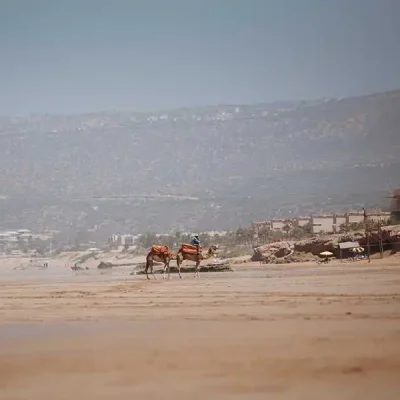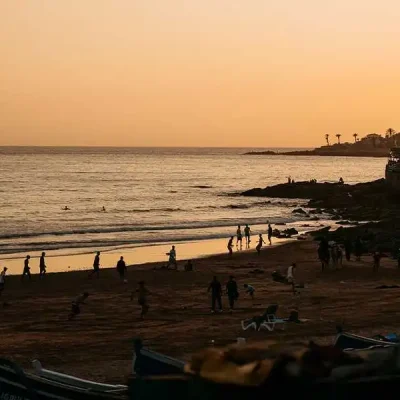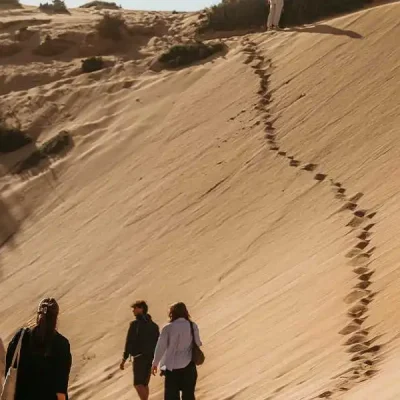How to Get to Taghazout?
Reaching the tranquil coastal haven of Taghazout is a straightforward journey from the bustling city of Agadir, which serves as the primary gateway with its international airport, Al Massira (AGA). The a-la-carte options for transportation cater to every budget, travel style, and need for independence.
By Taxi:
Taxis offer the most direct and flexible way to get from Agadir to Taghazout. Understanding the two main types of taxis in Morocco is crucial for a smooth journey.
Grand Taxis:
These are large, often aging, Mercedes-Benz sedans that serve as shared inter-city transport. They are the backbone of local long-distance travel. In Agadir, you’ll find the grand taxi stand near the main bus station (Gare Routière). To get to Taghazout, look for a grand taxi heading north. The journey operates on a fixed price per person, which is very affordable, typically around 20-30 dirhams. The catch? The taxi won’t depart until all six passenger seats are filled. This can mean a short wait or, if you’re impatient, the option to pay for the empty seats to get an express departure. Grand taxis are a fantastic way to meet locals and other travelers, providing an authentic slice of Moroccan life. The driver will likely drop you off at the entrance to Taghazout, from where you can walk or take a short “petit taxi” ride to your accommodation.
Petit Taxis:
These are the small, red-colored taxis found exclusively within city limits. While you can’t take a petit taxi from the Agadir Airport all the way to Taghazout, you can use them to get to the grand taxi stand. However, if you are looking for a private, direct transfer, some petit taxis might be willing to take you to Taghazout for a negotiated lump sum. This is a much more expensive option, usually costing between 200-300 dirhams, but offers the convenience of a door-to-door service, especially useful if you are traveling with a lot of luggage or in a group of two or three. It’s essential to agree on the price before you get in. This mode of transport is significantly faster, taking only 30-45 minutes depending on traffic.
Airport Taxis:
For the ultimate convenience upon arrival at Agadir’s Al Massira Airport, you can find a dedicated taxi stand. These taxis are typically grand taxis, and the fare to Taghazout is fixed and non-negotiable, usually around 300 dirhams. This is the most hassle-free option after a long flight, as you won’t need to worry about haggling or finding the right taxi stand in the city.
By Bus:
For the budget-conscious traveler, the bus is the most economical way to reach Taghazout.
Local Buses:
The local bus system offers a frequent and incredibly cheap connection between Agadir and Taghazout. From the main bus station in Agadir (Gare Routière), look for bus line 32 or 33. The journey is a picturesque one, hugging the coastline. The fare is a mere 7-8 dirhams, and the bus runs regularly throughout the day. The journey can take anywhere from an hour to an hour and a half due to frequent stops, but it’s an excellent way to soak in the local atmosphere. Be prepared for a bustling, sometimes crowded ride. It’s best to keep your valuables close and secure. The bus drops you off on the main road at the entrance to Taghazout village, a short walk from most accommodations.
Supratours and CTM:
While these companies primarily service long-distance routes, a few of their buses heading north from Agadir (e.g., to Essaouira) might have a stop on the main highway near Taghazout. This is a less reliable option for this short route, but it’s worth checking if you are arriving from a different city in Morocco. These buses are modern, air-conditioned, and provide a more comfortable ride.
By Car:
Renting a car in Agadir provides the ultimate freedom and flexibility to not only get to Taghazout but also to explore the stunning region at your leisure. Several international and local car rental agencies operate at the Agadir Airport and within the city.
The Drive:
The drive from Agadir to Taghazout is incredibly scenic and straightforward. Follow the N1 coastal highway north from Agadir. The road is well-maintained and the journey takes around 30-40 minutes. The final approach to Taghazout reveals breathtaking views of the coastline and the village nestled between the mountains and the sea.
Parking:
This is the most significant challenge of driving in Taghazout. The village itself is characterized by narrow, winding streets, and official parking spaces are extremely limited. It’s often easier to park on the main road at the entrance to the village and walk to your accommodation. Some surf camps and larger hotels offer dedicated parking, so it’s essential to check this in advance. In many areas, you’ll encounter a “gardien de voiture” (car guardian) who, for a small fee, will “watch” your car. It’s a customary practice and paying them ensures your car is looked after. Having a car is a huge advantage for exploring surrounding areas like Paradise Valley or the Toboga Dunes without relying on tours or taxis.
Popularity of Taghazout:
The transformation of Taghazout from a modest fishing village to a globally acclaimed travel hotspot is a fascinating story of cultural and geographic convergence. Its meteoric rise in popularity is no accident; it is the result of a unique blend of natural assets and a distinct cultural identity.
World-Class Surf Breaks:
This is, without a doubt, the primary driver of Taghazout’s fame. The village sits at the heart of Morocco’s “Surf Mecca,” a stretch of coastline with an incredible concentration of world-class point breaks. The geography of the coast and the direction of the swells create long, powerful, and perfectly peeling right-hand waves.
Anchor Point:
The legendary big wave spot, often considered the jewel in Taghazout’s crown. When a big swell hits, Anchor Point offers rides of several hundred meters, attracting pro surfers from all over the world. It’s a powerful wave and best left to the experts.
Killer Point:
Another long right-hand point break known for its consistency and long, hollow sections. Named after the orcas (killer whales) sometimes seen offshore.
Hash Point:
A user-friendly, mellow point break right in front of the village. It’s perfect for intermediate surfers and offers long rides without the heavy-duty power of the more famous spots.
Panorama Point:
Located at the southern end of Taghazout beach, this spot is ideal for beginners and longboarders, offering gentle, rolling waves.
Mysteries:
A reef break that works on a lower tide and is known for its fast, fun waves.
The abundance of surf spots within a short radius, combined with a consistent swell window from October to April, ensures that there is a wave for every skill level, every day. The warm water and sunny climate further sweeten the deal, making it a year-round surfing haven.
The Bohemian Vibe and Laid-Back Atmosphere:
While the waves attract people, the village’s unique atmosphere makes them stay. Taghazout is refreshingly different from other Moroccan tourist hubs like Marrakech or Fes. The pace of life is slow and centered around the tide and the sun. People walk barefoot, the scent of saltwater and grilled fish hangs in the air, and there is a pervasive sense of tranquility. It’s a place where you can truly disconnect from the digital noise and reconnect with yourself. The village has a strong sense of community, where locals, long-term expats, and transient travelers coexist harmoniously, creating a tolerant and welcoming environment.
A Haven for Digital Nomads and Remote Workers:
In the post-COVID world, the “workation” trend has exploded, and Taghazout has emerged as a top contender. The ingredients are perfect: affordable living, a beautiful and inspiring environment, and a growing number of cafes and accommodations with fast, reliable Wi-Fi. The time zone is also convenient for those working with European or US clients. The daily routine of a digital nomad in Taghazout might involve a morning surf or yoga session, a few hours of focused work in a beachside café, a leisurely lunch, and then an afternoon of exploring or a second surf session, all capped off with a stunning sunset. The community of like-minded individuals is a huge draw, offering networking opportunities and a support system for those on the road.
Evolving Infrastructure:
Taghazout has managed to grow without losing its soul. While the number of hotels, restaurants, and surf camps has increased, the development has been largely organic and in line with the village’s low-rise aesthetic. The new Taghazout Bay resort area, just south of the village, has brought a touch of luxury and modern amenities while keeping a respectful distance from the traditional core. This careful balance ensures that the village can accommodate more visitors without becoming a sterile, over-commercialized hub.
Where to Stay in Taghazout?
Taghazout’s accommodation landscape is as diverse as its visitors. From simple backpacker hostels to luxurious surf villas, there’s a perfect place for every budget and preference.
Surf Camps:
These are the heart and soul of Taghazout’s accommodation scene. Surf camps offer a comprehensive package that typically includes lodging (often in shared dorms or private rooms), daily surf lessons, equipment rental (board and wetsuit), and transport to the best surf spots of the day. They often include meals and other activities like yoga, day trips, and social evenings. This option is ideal for solo travelers, beginners, and anyone looking for a full-immersion experience with a built-in community. Famous camps like Surf Berbere and Taghazout Surf Camp have been operating for years and have perfected the art of the surf trip.
Hostels and Guesthouses:
For independent travelers and budget-conscious backpackers, Taghazout offers a wide selection of hostels and guesthouses. These are often smaller, family-run establishments that provide a more authentic and intimate experience. You can find both private rooms and dorm beds. They typically have communal kitchens, rooftop terraces with epic views, and a friendly atmosphere. Examples include The Surf Hostel or Amouage Surf & Yoga Guesthouse.
Riads and Boutique Hotels:
For those seeking more comfort and a touch of luxury, Taghazout has a growing number of boutique hotels and traditional Moroccan riads. These beautiful spaces are designed with intricate tilework, courtyards, and rooftop pools. They offer a more tranquil and private experience. Many of them are oceanfront, providing spectacular views right from your window. The brand-new Taghazout Bay area also has several high-end resorts, offering a different, more polished vibe.
Apartments and Villas:
For long-term stays, digital nomads, or families, renting an apartment or villa through platforms like Airbnb is an excellent choice. This gives you the freedom of having your own space, a kitchen to cook your own meals, and a home-like atmosphere. You can find anything from a simple studio to a multi-bedroom villa with a private pool.
Choosing Your Location:
Taghazout is a small village, but the location of your accommodation can still impact your experience.
Village Center:
Stay here if you want to be in the heart of the action, close to cafes, restaurants, and the main beach. It can be a little noisy, but the convenience is unmatched.
The Main Road:
Accommodations on the main road offer easy access to transport and often have great ocean views.
Taghazout Bay Area:
A short drive or walk south, this area is home to modern resorts and quieter, more manicured surroundings. Ideal if you’re looking for luxury and tranquility.
Things to do in Taghazout:
Taghazout’s charm extends far beyond its surf breaks. The village and its surroundings offer a rich tapestry of experiences that cater to adventurers, culture seekers, and those simply looking to unwind.
Surfing: A Deeper Dive
Taghazout is a surfer’s paradise, but knowing the spots and the right time to visit can make all the difference.
Beginner's Paradise:
For those new to the sport, Taghazout has several perfect spots. Banana Point in Tamraght and Panorama Point in Taghazout offer mellow, sandy-bottom waves that are ideal for learning. They are less crowded and safer than the main point breaks.
Intermediate Playground:
Once you’ve mastered the basics, you can move on to spots like Hash Point and Crocodile Rock. These offer longer rides and more consistent waves but are still manageable and fun.
Advanced Challenges:
For the experienced surfer, the legendary spots await. Anchor Point is the ultimate challenge on a big swell, offering long, barreling rights. Killer Point and Boilers are also powerful reef breaks that require skill and respect.
The best time to surf in Taghazout is from October to April, when consistent groundswells produce the most epic waves. But fear not, the summer months offer smaller, more user-friendly waves that are perfect for beginners and longboarders.
Beaches:
Beyond the main surfing beaches, the coastline offers a number of beautiful spots to relax.
Taghazout Beach:
The main stretch of sand in the village is a bustling hub of activity. It’s a great place to people-watch, play football, or simply soak up the sun.
Imourane Beach (Banana Village):
A short drive south, this beach is a local favorite. The sand is soft, and the waves are gentle. It’s an excellent spot for families and a quieter alternative to the main beach.
Devil's Rock:
A quirky little bay with a distinctive rock formation. It’s a popular spot for sunbathing and offers a good beginner’s wave on certain tides.
Taghazout Bay Promenade:
This modern addition to the coastline is a refreshing contrast to the rustic charm of the village. The promenade is a beautifully designed walkway that connects the high-end resorts and offers a manicured space for a stroll. The architecture is a blend of modern design and traditional Moroccan elements. You can find upscale cafes, restaurants, and shops here, making it a great place to spend a more relaxed evening.
Surrounding Villages:
A key part of the Taghazout experience is venturing beyond the main village.
Tamraght:
Just south of Taghazout, Tamraght is a quieter village with its own laid-back vibe. It’s home to several popular surf spots and a more local feel.
Aourir (Banana Village):
This bustling village is famous for its vibrant Tuesday souk. It’s a sensory overload of sights, sounds, and smells. Here you can buy fresh produce, spices, textiles, and traditional Moroccan goods at a fraction of the price you’d find in the tourist areas.
Imsouane:
A longer day trip, about 1.5 hours north of Taghazout, Imsouane is another surfing hotspot with what is often called “The Longest Wave in Africa.” It’s a beautiful, remote fishing village and an essential pilgrimage for any serious surfer.
Sunsets:
Taghazout is famous for its sunsets, and for good reason. The sun sinks directly into the Atlantic, painting the sky in a breathtaking palette of reds, oranges, and purples. There’s a ritual to it: as the sun begins to descend, people gather on the rooftops of their guesthouses, on the beach, or at a cliffside cafe, sharing a moment of collective awe.
Seafood:
Taghazout’s fishing heritage means that fresh, delicious seafood is never far away. You can find fishermen selling their daily catch right on the beach in the afternoon. The best way to experience it is at one of the small, family-run restaurants where you can pick your fish (sardines, sea bream, calamari, octopus) and have it grilled to perfection. The prices are incredibly reasonable, and the taste is unparalleled.
SkatePark:
Tucked away between the village and the new development, the Taghazout skatepark is a testament to the village’s diverse subcultures. It’s a beautifully designed concrete park that attracts skaters from all over the world. It’s a great place to meet people, practice your kickflips, or simply sit and watch the action.
Toboga Dunes:
Located a short taxi ride from Taghazout, the Toboga Dunes offer an unexpected thrill. These massive sand dunes are a perfect playground for sandboarding. Rent a board and slide down the dunes. It’s a fun, active way to spend an afternoon, especially on a windier day.
Yoga:
The serene environment of Taghazout makes it a natural hub for yoga. Many of the surf camps and guesthouses offer daily yoga classes, often held on a rooftop overlooking the ocean at sunrise or sunset. The combination of surfing and yoga is incredibly popular, as yoga helps with balance, flexibility, and strength—all essential for surfing. You can find classes catering to all levels, from beginners to advanced practitioners.
Paradise Valley:
This is arguably the most popular day trip from Taghazout. Located about an hour inland, Paradise Valley is a spectacular oasis nestled in the foothills of the Atlas Mountains. The journey itself is a treat, winding through argan tree-covered hills and Berber villages. The valley features a series of stunning natural pools, waterfalls, and rock formations. You can swim, cliff jump (at your own risk), or simply relax and enjoy the incredible natural beauty. It’s a great escape from the coast and a glimpse into Morocco’s diverse landscape.
Workation and Freelancing:
Taghazout is not just a destination for vacationers; it’s a thriving hub for digital nomads. The village offers a unique blend of productivity and relaxation. Many cafes offer high-speed internet, allowing freelancers to work with a view of the ocean. There is a sense of community among remote workers, with co-working spaces and a culture of collaboration. The affordability of life, combined with the inspiring environment and access to outdoor activities, makes it an ideal place to find a work-life balance.
Restaurants:
Taghazout’s culinary scene is a delight. You’ll find a mix of traditional Moroccan food and international cuisine.
Traditional Moroccan:
Don’t miss out on trying a classic tagine or couscous. Look for small, family-run places for the most authentic experience.
Fresh Fish:
The seafood is a highlight. Look for the “fish man” on the main street with his stall of fresh catches or eat at a restaurant where you can select your fish.
International Cuisine:
From wood-fired pizza to vegan poke bowls, the international influence of Taghazout’s visitors is reflected in its food. Many cafes cater to a global palate, so you’ll have no trouble finding something you like.
Cafes and Juice Bars:
Start your day with a fresh orange juice or a smoothie from one of the many juice stands.
Shopping and Souvenirs:
While not a shopping hub like Marrakech, Taghazout offers unique, locally made goods. You can find traditional Moroccan blankets, leather goods, and argan oil products. The local artisans are incredibly talented, and buying from them directly is a great way to support the community. The Tuesday souk in Aourir is a fantastic place to buy spices, dates, and other local products.
Nightlife and Social Scene:
Taghazout’s nightlife is laid-back and centered around a few key spots. Many cafes and hostels host live music nights, often with local musicians playing traditional Berber tunes. You’ll also find a few bars and pubs where you can enjoy a drink and socialize with other travelers and locals. The atmosphere is generally low-key and friendly, a perfect end to a day of surfing and exploring.
Cooking Classes:
For the culinary curious, some guesthouses and local families offer cooking classes. This is a fantastic way to learn how to prepare traditional Moroccan dishes like tagine, pastilla, or couscous. It’s a hands-on, immersive experience that gives you a deeper appreciation for Moroccan culture.
Conclusion:
In conclusion, Taghazout is an extraordinary destination that offers an unparalleled mix of adventure, relaxation, and cultural immersion. While its waves may be its claim to fame, the village’s true magic lies in its vibrant community, breathtaking landscapes, and the endless array of experiences waiting to be discovered. It’s a place that welcomes you with open arms and leaves you with memories that will last a lifetime.






